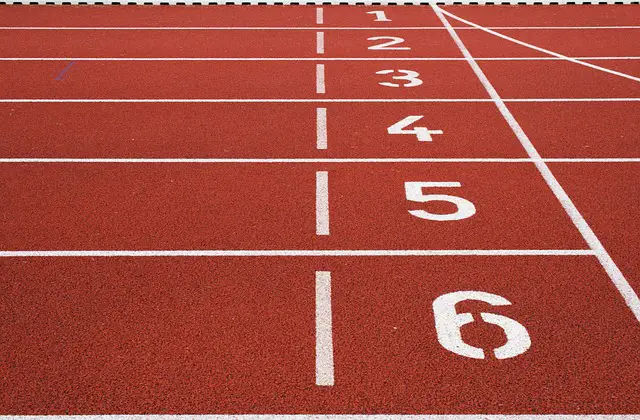“Track” refers to running events on a designated course, while “field” encompasses jumping, throwing, and vaulting events in a sports competition.
TL;DR Track events Vs. Field events
Track events are fast-paced and require athletes to compete against each other in races or relays. These include sprints like the 100-meter dash or longer distances like the 1500 meters. They also encompass hurdle races, steeplechase, and relay races such as the 4×100 meters.
Field events emphasize strength, technique, and agility. Athletes participate individually rather than directly competing against one another at the same time. Disciplines within this category include long jump, high jump, shot put, discus thrower javelin throw.
What are track events?

Track events are athletic competitions held on an oval track. They include sprints, middle-distance, and long-distance races, hurdles, and relays.
Athletes compete on designated lanes, with distances ranging from 60 meters to 10,000 meters. Sprints, like the 100m, emphasize speed, while middle-distance events, such as the 800m, require a balance of speed and endurance. Long-distance races, including the 5,000m and 10,000m, test athletes’ stamina.
Hurdle events involve jumping over barriers at set distances. Relay races feature teams passing a baton. Track events showcase a variety of skills, from explosive speed to strategic pacing, making them a core component of athletics competitions worldwide.
What are field events?

Field events in athletics encompass a diverse range of competitions that showcase athletes’ strength, agility, and technique. These events take place on the field rather than the track. Notable examples include:
- Jumping Events: Long Jump, High Jump, Triple Jump: Athletes aim for maximum distance or height.
- Throwing Events: Shot Put, Discus Throw, Hammer Throw, Javelin Throw: Competitors launch objects for distance.
- Vaulting Events: Pole Vault: Athletes use a pole to clear a crossbar at increasing heights.
These events require specialized skills and techniques, emphasizing power, precision, and coordination. Athletes participating in field events contribute to their team’s overall score, and their performances are crucial in determining success in track and field competitions at various levels, from local meets to international championships.
Track events Vs. Field events – Key differences
| Criteria | Track Events | Field Events |
|---|---|---|
| Nature of Competition | Races on a designated oval track, usually in lanes | Competitions on a field, involving jumps, throws, and vaults |
| Athletic Movements | Running, sprinting, hurdling, and relay races | Jumping, throwing, and vaulting activities |
| Distance Measurement | Measured in meters (e.g., 100m, 800m, 5000m) | Measured in meters (e.g., long jump, shot put) |
| Examples | Sprints (100m, 200m), middle-distance (800m), relays | Long jump, high jump, shot put, javelin throw |
| Lanes or Areas | Lanes designated for each runner on the track | Specific areas designated for each field event participant |
| Scoring in Competitions | Points awarded based on finishing position and time | Points awarded based on distances achieved or heights cleared |
| Equipment Used | Starting blocks, hurdles, batons (for relays) | Various implements such as javelins, shots, poles for vaulting |
| Skills Emphasized | Speed, endurance, technique in passing batons | Strength, precision, and technique in jumping, throwing, or vaulting |
| Athlete Participation | Runners, sprinters, hurdlers, relay teams | Jumpers, throwers, vaulters |
| Event Duration | Typically shorter in duration | May have longer durations, especially in multi-attempt competitions |
| Overall Contribution | Contributes to a team's overall score | Contributes to a team's overall score |
| Setting | Takes place on the track within the stadium | Takes place in designated areas on the field |
Image Credits
Featured Image By – Pexels from Pixabay
Image 1 By – Pirmin Lenherr from Pixabay








